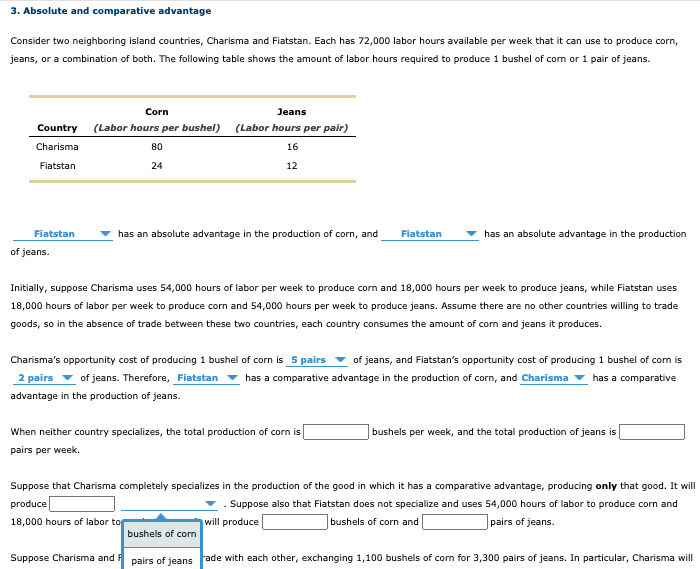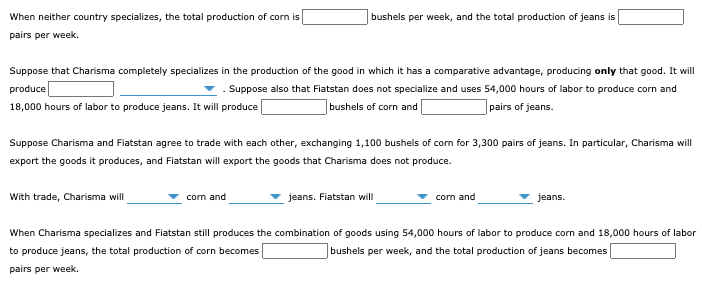3. Absolute and comparative advantage Consider two neighboring island countries, Charisma and Fiatstan. Each has 72,000 labor hours available per week that it can use to produce corn, jeans, or a combination of both. The following table shows the amount of labor hours required to produce 1 bushel of corn or 1 pair of jeans. Corn Jeans Country (Labor hours per bushel) (Labor hours per pair) Charisma 80 16 Fiatstan 24 12 Fiatstan has an absolute advantage in the production of corn, and Fiatstan has an absolute advantage in the production of jeans. Initially, suppose Charisma uses 54,000 hours of labor per week to produce corn and 18,000 hours per week to produce jeans, while Fiatstan uses 18,000 hours of labor per week to produce corn and 54,000 hours per week to produce jeans. Assume there are no other countries willing to trade goods, so in the absence of trade between these two countries, each country consumes the amount of corn and jeans it produces. Charisma's opportunity cost of producing 1 bushel of corn is 5 pairs 2 pairs v of jeans. Therefore, Fiatstan of jeans, and Fiatstan's opportunity cost of producing 1 bushel of corn is has a comparative advantage in the production of corn, and Charisma has a comparative advantage in the production of jeans. When neither country specializes, the total production of corn is bushels per week, and the total production of jeans is pairs per week. Suppose that Charisma completely specializes in the production of the good in which it has a comparative advantage, producing only that good. It w produce . Suppose also that Fiatstan does not specialize and uses 54,000 hours of labor to produce corn and 18,000 hours of labor top will produce bushels of corn and pairs of jeans. bushels of corn
3. Absolute and comparative advantage Consider two neighboring island countries, Charisma and Fiatstan. Each has 72,000 labor hours available per week that it can use to produce corn, jeans, or a combination of both. The following table shows the amount of labor hours required to produce 1 bushel of corn or 1 pair of jeans. Corn Jeans Country (Labor hours per bushel) (Labor hours per pair) Charisma 80 16 Fiatstan 24 12 Fiatstan has an absolute advantage in the production of corn, and Fiatstan has an absolute advantage in the production of jeans. Initially, suppose Charisma uses 54,000 hours of labor per week to produce corn and 18,000 hours per week to produce jeans, while Fiatstan uses 18,000 hours of labor per week to produce corn and 54,000 hours per week to produce jeans. Assume there are no other countries willing to trade goods, so in the absence of trade between these two countries, each country consumes the amount of corn and jeans it produces. Charisma's opportunity cost of producing 1 bushel of corn is 5 pairs 2 pairs v of jeans. Therefore, Fiatstan of jeans, and Fiatstan's opportunity cost of producing 1 bushel of corn is has a comparative advantage in the production of corn, and Charisma has a comparative advantage in the production of jeans. When neither country specializes, the total production of corn is bushels per week, and the total production of jeans is pairs per week. Suppose that Charisma completely specializes in the production of the good in which it has a comparative advantage, producing only that good. It w produce . Suppose also that Fiatstan does not specialize and uses 54,000 hours of labor to produce corn and 18,000 hours of labor top will produce bushels of corn and pairs of jeans. bushels of corn
Principles of Microeconomics
7th Edition
ISBN:9781305156050
Author:N. Gregory Mankiw
Publisher:N. Gregory Mankiw
Chapter3: Interdependence And The Gains From Trade
Section: Chapter Questions
Problem 5PA
Related questions
Question
Only after When neither country specializes, the total production of corn

Transcribed Image Text:3. Absolute and comparative advantage
Consider two neighboring island countries, Charisma and Fiatstan. Each has 72,000 labor hours available per week that it can use to produce corn,
jeans, or a combination of both. The following table shows the amount of labor hours required to produce 1 bushel of com or 1 pair of jeans.
Corn
Jeans
Country
(Labor hours per bushel)
(Labor hours per pair)
Charisma
80
16
Fiatstan
24
12
Fiatstan
has an absolute advantage in the production of corn, and
Fiatstan
has an absolute advantage in the production
of jeans.
Initially, suppose Charisma uses 54,000 hours of labor per week to produce corn and 18,000 hours per week to produce jeans, while Fiatstan uses
18,000 hours of labor per week to produce corn and 54,000 hours per week to produce jeans. Assume there are no other countries willing to trade
goods, so in the absence of trade between these two countries, each country consumes the amount of corn and jeans it produces.
Charisma's opportunity cost of producing 1 bushel of corn is 5 pairs v of jeans, and Fiatstan's opportunity cost of producing 1 bushel of com is
2 pairs
of jeans. Therefore, Fiatstan
has a comparative advantage in the production of corn, and Charisma
has a comparative
advantage in the production of jeans.
When neither country specializes, the total production of corn is
bushels per week, and the total production of jeans is
pairs per week.
Suppose that Charisma completely specializes in the production of the good in which it has a comparative advantage, producing only that good. It will
produce
Suppose also that Fiatstan does not specialize and uses 54,000 hours of labor to produce corn and
18,000 hours of labor to
will produce
bushels of corn and
pairs of jeans.
bushels of con
Suppose Charisma and pairs of jeans fade with each other, exchanging 1,100 bushels of corn for 3,300 pairs of jeans. In particular, Charisma will

Transcribed Image Text:When neither country specializes, the total production of corn is
bushels per week, and the total production of jeans is
pairs per week.
Suppose that Charisma completely specializes in the production of the good in which it has a comparative advantage, producing only that good. It will
produce
18,000 hours of labor to produce jeans. It will produce
. Suppose also that Fiatstan does not specialize and uses 54,000 hours of labor to produce corn and
|bushels of corn and
pairs of jeans.
Suppose Charisma and Fiatstan agree to trade with each other, exchanging 1,100 bushels of corn for 3,300 pairs of jeans. In particular, Charisma will
export the goods it produces, and Fiatstan will export the goods that Charisma does not produce.
With trade, Charisma will
corn and
jeans. Fiatstan will
corn and
jeans.
When Charisma specializes and Fiatstan still produces the combination of goods using 54,000 hours of labor to produce corn and 18,000 hours of labor
to produce jeans, the total production of corn becomes
bushels per week, and the total production of jeans becomes
pairs per week.
Expert Solution
This question has been solved!
Explore an expertly crafted, step-by-step solution for a thorough understanding of key concepts.
This is a popular solution!
Trending now
This is a popular solution!
Step by step
Solved in 2 steps

Recommended textbooks for you

Principles of Microeconomics
Economics
ISBN:
9781305156050
Author:
N. Gregory Mankiw
Publisher:
Cengage Learning

Principles of Macroeconomics (MindTap Course List)
Economics
ISBN:
9781305971509
Author:
N. Gregory Mankiw
Publisher:
Cengage Learning

Brief Principles of Macroeconomics (MindTap Cours…
Economics
ISBN:
9781337091985
Author:
N. Gregory Mankiw
Publisher:
Cengage Learning

Principles of Microeconomics
Economics
ISBN:
9781305156050
Author:
N. Gregory Mankiw
Publisher:
Cengage Learning

Principles of Macroeconomics (MindTap Course List)
Economics
ISBN:
9781305971509
Author:
N. Gregory Mankiw
Publisher:
Cengage Learning

Brief Principles of Macroeconomics (MindTap Cours…
Economics
ISBN:
9781337091985
Author:
N. Gregory Mankiw
Publisher:
Cengage Learning

Principles of Economics, 7th Edition (MindTap Cou…
Economics
ISBN:
9781285165875
Author:
N. Gregory Mankiw
Publisher:
Cengage Learning

Principles of Economics (MindTap Course List)
Economics
ISBN:
9781305585126
Author:
N. Gregory Mankiw
Publisher:
Cengage Learning

Principles of Macroeconomics (MindTap Course List)
Economics
ISBN:
9781285165912
Author:
N. Gregory Mankiw
Publisher:
Cengage Learning